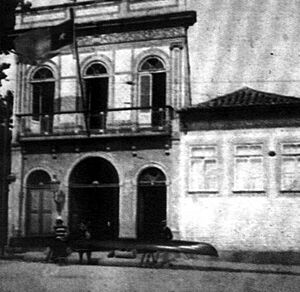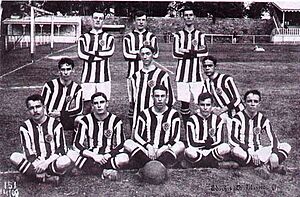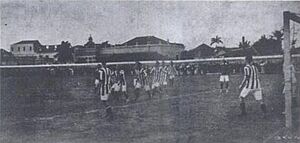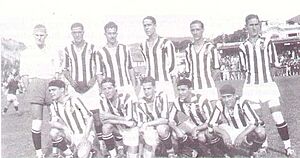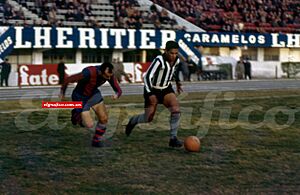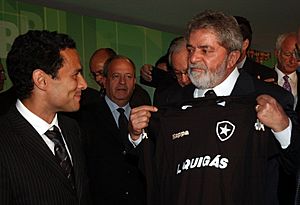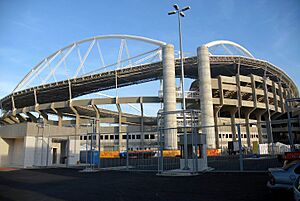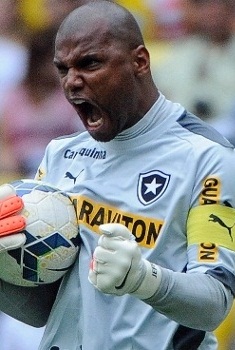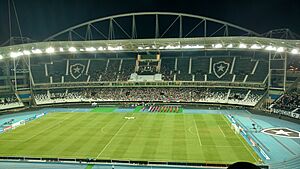History of Botafogo de Futebol e Regatas facts for kids
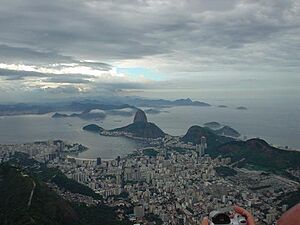
The history of Botafogo de Futebol e Regatas began in 1891. That year, the Botafogo Regatta Group was started in Rio de Janeiro. Three years later, this group became the Club de Regatas Botafogo. Then, in 1904, the Botafogo Football Club was created. For 38 years, these two clubs existed separately. Finally, in 1942, they joined together to form Botafogo de Futebol e Regatas. Today, it is one of Brazil's most famous sports clubs.
Botafogo is known for the five-pointed star on its badge, which gives it the nickname "Lonely Star Club." Its official colors are black and white. Since 2007, the club has played its football matches at the Nilton Santos Stadium, also known as Engenhão. Its main rivals are Flamengo, Fluminense, and Vasco da Gama.
FIFA chose Botafogo as one of the greatest clubs of the 20th century. Among its many titles are twenty-one Carioca Championships, four Rio-São Paulo Tournaments, two Brazilian Championships, and one CONMEBOL Cup. The CONMEBOL Cup was a competition before the current Copa Sudamericana.
The club also holds some amazing records in Brazilian football. It has the record for the most matches without losing: 52 games between 1977 and 1978. It also holds the record for undefeated matches in the Brazilian Championship: 42 games, also from 1977 to 1978. Botafogo has had the most players participate in games for the Brazilian National team, with 1100 appearances. It also sent the most players to World cup tournaments. The club is also responsible for the biggest victory ever in Brazilian football: 24–0 against Sport Club Mangueira in the 1909 Carioca Championship.
Contents
- How Botafogo Started
- Football History
- The Early Years: "The Glorious One" Appears
- A Quiet Period (1912-1930)
- The Four-Time Champions of the 1930s
- The 1940s: A Time of Waiting
- The Golden Age (1950s and 1960s)
- A Long Wait for Titles (1970s and 1980s)
- The 1990s: More Titles and "Tuliomania"
- The 2000s: A Difficult Time
- The 2010s: Ups and Downs
- The 2020s: Challenges and a Comeback
- Basketball
- Swimming
- Water Polo
- Rowing
- Volleyball
How Botafogo Started
Early Clubs
Botafogo's story began in 1891. Members of another club, Clube Guanabarense, created the Grupo de Regatas Botafogo. One of its founders was a rower named Luiz Caldas. After Caldas passed away, the group became the Club de Regatas Botafogo. This club had its first office in a large house near Botafogo Beach.
Later, on August 12, 1904, a new football team was formed. It was called Electro Club. Two young students, Flávio Ramos and Emmanuel Sodré, started it. A little over a month later, Flávio's grandmother suggested a new name. The club changed its name to Botafogo Football Club.
The Clubs Join Together
Botafogo de Futebol e Regatas was officially created on December 8, 1942. This was the day the two clubs, Club de Regatas Botafogo and Botafogo Football Club, finally joined. People had thought about merging them since 1931. However, some people resisted it for many years.
In the 1940s, a sad event brought the clubs together. On June 11, 1942, the two Botafogo clubs played each other in a basketball game. It was for the Carioca Championship. Armando Albano, a top player for Botafogo Football Club, collapsed during the game. He was taken to the locker room. The game continued, but soon the news came that he had died. The match was stopped. The leaders of both clubs were very sad. They decided it was time for the clubs to merge.
After this, the process to combine the clubs began. It became official about six months later. Botafogo de Futebol e Regatas was born. The flag kept its black and white stripes. The old badge with the letters BFC was changed. It became a black rectangle with the white Lone Star.
Football History
The Early Years: "The Glorious One" Appears
In 1906, Botafogo won its first trophy, the Caxambu Cup. This was the first football competition in Rio de Janeiro. In the same year, the club played in the first Carioca Championship. They finished in 4th place. Their first win in this competition was 1–0 against Bangu.
In 1907, Botafogo was involved in a big argument. They were tied with Fluminense in points for the Carioca Championship. Fluminense said they were champions. Botafogo disagreed because their last game was a "W.O." win. This meant the other team didn't show up. Botafogo felt they didn't get a chance to score more goals. The argument lasted for 89 years! Finally, in 1996, both Botafogo and Fluminense were declared champions of 1907.
In the 1909 Carioca Championship, Botafogo finished second. But they made history with the biggest score ever in Brazilian football: 24–0 against Mangueira. In the first half, they scored 9 goals. In the second half, they scored 15 goals. Each half was 40 minutes long. This means Botafogo scored a goal about every 3.3 minutes! Gilbert Hime scored nine goals, and Flávio Ramos scored seven. This amazing result is shown in the Football Museum.
In 1910, Botafogo won the Carioca Championship. They scored 66 goals in 10 games! They had big wins like 9–1 and 15–1. In the final, they beat Fluminense 6–1. This historic season earned the club its nickname: "O Glorioso" (The Glorious One). That year, they also won the Interstate Trophy. They beat AA Palmeiras, the champions from São Paulo, 7–2.
In 1911, the club left the Metropolitan Athleticos Sports League. This league organized the Carioca Championship. During a game, a fight broke out. Some Botafogo players were suspended. This made the club's managers angry. So, Botafogo only played friendly matches for a while. In 1912, they played in a different league and became champions again.
A Quiet Period (1912-1930)
From 1912 to 1930, Botafogo didn't win any major titles. However, they were runners-up in the Carioca Championship four times. They also had several top scorers during this time.
In the early 1910s, the club opened the General Severiano Stadium. In its first game, Botafogo beat Flamengo 1–0. This period also saw the start of a common term in Brazilian sports. The word "cartola" (top hat) began to be used for club managers. This happened when Uruguayan directors wore fancy top hats to a match.
In the 1920s, Botafogo's best result was 3rd place in 1928. In 1923, they almost got sent down to a lower division. They had to play a special game to stay in the top league. They won 3–1 and remained in the A Division.
This time also had some problems within the club. In 1924, a manager left, and his nephew, star player Nilo, went to rival Fluminense. Nilo only returned to Botafogo in 1927.
The Four-Time Champions of the 1930s
At the start of the 1930s, Botafogo won the 1930 Carioca Championship. They were led by star players Nilo and Carvalho Leite. In 1931, they won the Rio-São Paulo State Champions Cup. They beat Corinthians 7–1, with Nilo scoring four goals.
In 1932, Botafogo became champions with two games left to play. From 1933, two different leagues organized the Carioca Championship. Botafogo stayed in the league that didn't want to make football professional. They won championships in 1933 and 1934. In 1935, the leagues changed again. Botafogo won the title once more, becoming four-time champions. They were the first professional state champions recognized by the Brazilian Sports Confederation. Leônidas da Silva, a famous player, played for Botafogo during this time.
In 1936, the club went on its first international trip. They played friendly matches in Mexico and the United States. They won six out of nine games. The next year, the General Severiano Stadium was renovated. It was made bigger with new seats. In 1938, they reopened it with a 3–2 win over Fluminense.
During this era, many Botafogo players went to the World cup. In 1934, nine players from the club were called up for the World Cup in Italy.
The 1940s: A Time of Waiting
In the early 1940s, Botafogo had many great players. But they couldn't win any major titles. Even Heleno de Freitas, one of Botafogo's biggest stars, left without winning a trophy. He scored 209 goals in 235 games for the club. He was part of a famous attacking group for the Brazilian National team.
After Heleno left in 1948, Botafogo finally won the Carioca Championship again. They had finished second three times in a row. In 1948, they started by losing 4–0. But after that, they never lost again in the competition. In the last game, Botafogo beat Vasco 3–1 and became champions.
The 1948 Carioca Championship also saw the arrival of one of the club's mascots. A dog named Biriba, who belonged to a player, ran onto the field during a game. He seemed to be celebrating a big win. The club president loved the dog, especially its black and white fur. He decided to adopt Biriba as the mascot. Biriba was at every game to "bring luck." If Botafogo was losing, the dog would be let onto the field to stop the game. After this, Botafogo often managed to win!
The Golden Age (1950s and 1960s)
The 1950s and 1960s were a golden age for Botafogo. Many stars of the Brazilian National Team played for the club. These included Manga, Zagallo, Didi, and Gérson. The two biggest idols in Botafogo's history also played then: Nilton Santos, considered the best left-back ever, and Garrincha, who some say was the best player in football history.
In 1951, Botafogo won the Municipal Tournament. They were invited to play in the first Small Club World Cup in Venezuela. They played against famous teams like Real Madrid. Botafogo didn't lose any games but finished second.
A year later, Botafogo introduced Garrincha to the world. He played his first professional game on July 19, 1953. He scored three goals in a 6–3 win.
In 1957, the club did something new. They asked sports writer João Saldanha to coach the main team. Even without coaching experience, he led the team to win the Carioca Championship. In the final, Botafogo beat Fluminense 6–2. Paulinho Valentim scored five goals! This is still the highest score in a state final.
The next year, Botafogo lent its best players to the Brazilian National Team. Garrincha, Nilton Santos, Didi, and Zagallo helped Brazil win its first World Cup title. Even without them, Botafogo won a tournament. They also beat Vasco da Gama 5–0, their biggest win against that rival.
In 1961, Botafogo won the Carioca Championship. They beat Flamengo 3–0 in the final. The next year, they won three titles. They were champions of the Carioca Championship again, beating Flamengo 3–0. They also won the Rio-São Paulo Tournament for the first time. In 1962, Garrincha led Brazil to win the World Cup again. Five other Botafogo players were on that team.
In 1963, Botafogo reached the final of the Brazilian Championship. They lost to Santos. They also lost to Santos in the semi-finals of the Libertadores Cup. A big win that year was the Paris International Tournament.
Botafogo got revenge against Santos in the 1964 Rio-São Paulo Tournament. Both teams were declared champions. That year, Botafogo also won two international titles.
The end of 1964 marked the farewell of Nilton Santos. He retired from football. He played 721 games for Botafogo and never played for another club. In 1965, Garrincha also left. He had knee problems. Even with their biggest stars leaving, Botafogo kept winning. They won several cups and tournaments in the mid-1960s.
In 1967 and 1968, coached by Zagallo, Botafogo won the Guanabara Cup and the Carioca Championship twice. In 1969, Botafogo won the 1968 Brazil Cup. More than 30 years later, this was recognized as the club's first Brazilian Championship title.
A Long Wait for Titles (1970s and 1980s)
For 21 years, Botafogo did not win any major official titles. From 1968 until 1989, the club often finished second, third, or fourth.
In the 1971 Carioca Championship, Botafogo had four players who had won the World Cup the year before. They were leading the competition. But they stumbled in the last games. In the final match against Fluminense, Botafogo needed a draw. Fluminense scored the winning goal in a controversial play. Botafogo lost their chance.
The next year, the title escaped Botafogo again. They reached the final of the Brazilian Championship. They drew 0–0 with Palmeiras, who won the title because they had more points. In 1972, Botafogo also beat their biggest rival, Flamengo, 6–0.
In 1973, Botafogo played in the Libertadores Cup again after ten years. They advanced from their group. But they were eliminated in the semi-final round.
In 1976, Botafogo faced serious money problems. They sold their main office at General Severiano. This made many fans and former players, like Nilton Santos, very angry. He said, "they were killing Botafogo's glories."
During this time, Botafogo was nicknamed "Paddy Wagon Team." They didn't have many big stars. But they set two Brazilian football records: 52 unbeaten games in national football and 42 unbeaten games in the Brazilian Championship. Despite this, their league finishes were not great. In 1979, they finished 53rd, their worst ever.
In 1981, Botafogo had a good season. They reached the semi-final of the Brazilian Championship. The return match was full of arguments. Botafogo accused the other team of pressuring the referee. The game was stopped for 35 minutes. São Paulo ended up winning.
In 1988, Botafogo was still in the Brazilian Championship. They finished 17th. The most memorable moment was a 3–0 loss to Vasco da Gama. At the end of the game, an 11-year-old ball girl, Sonja Martinelli, cried. She declared her love for the club. Botafogo had not won an official title in 20 years.
The long wait for a title finally ended on June 21, 1989. Botafogo, led by players like Mauro Galvão, won the Carioca Championship. They were undefeated! They beat Flamengo, who had stars like Zico and Bebeto. The first game was a 0–0 draw. In the second game, Botafogo won with a controversial goal by Maurício.
The 1990s: More Titles and "Tuliomania"
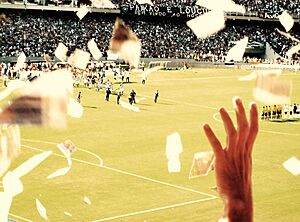
The year after their big win, Botafogo won the State Championship again. This time, it was a controversial final against Vasco.
In 1992, the club played in a Brazilian Championship final after twenty years. It was against rival Flamengo. Before the first game, a controversy happened. Botafogo's star player, Renato Gaúcho, made a bet with a Flamengo player. If Botafogo lost, he would host a barbecue for them. Botafogo lost 3–0. Renato paid the bet, which made the president and fans angry. He was dismissed from the second match. The return match ended in a 2–2 draw. This game was also marked by a tragedy at the Maracanã. A railing broke, and people fell. Three people died.
Even with finishing second in the Brazilian Championship, Botafogo qualified for the 1993 CONMEBOL Cup. The team didn't have many top players. They didn't even have enough money for training balls. But they still won their first official international title! Coached by Carlos Alberto Torres, they beat teams like Bragantino and Atlético Mineiro. In the final, they faced Peñarol from Uruguay. The first game was a 1–1 draw. Fans were so excited for the second game that they crowded outside the Maracanã. The stadium gates were opened. On the field, a 2–2 draw led to a penalty shootout. Goalkeeper Willian Bacana saved two penalties. Botafogo won 3–1 and took the trophy!
In 1994, Botafogo returned to their General Severiano headquarters. In the Brazilian Championship, they finished 5th. Túlio Maravilha was the top scorer with nineteen goals.
In 1995, Túlio continued to shine. In the Carioca Championship, he was again the top scorer with 27 goals. He called himself the "King of Rio." The biggest glory of the year came with the Brazilian Championship title. This was the club's first Brazilian title organized by the CBF. Besides Túlio, the team had players like Gonçalves and Donizete. They were coached by Paulo Autuori. Despite problems with late salaries, the team played well. They reached the final against Santos.
In the first game of the final, Botafogo won 2–1. The referee disallowed a good goal by Túlio. In the return match, there were many controversial calls by the referee. A 1–1 draw secured the trophy for Botafogo. Túlio Maravilha was the top scorer with 23 goals. He became one of the club's greatest idols.
The next season, the club sold many players. But they still won titles. They won the Cidade Maravilhosa Cup and the Teresa Herrera Trophy against Juventus, the Champions League winners. They also won cups in Japan and Russia. In the Libertadores Cup, they were eliminated in the round of 16.
In 1997, Botafogo won another Carioca Championship. They beat Vasco da Gama with a goal by Dimba. In 1998, the club won the Rio-São Paulo Tournament for the fourth time. They beat São Paulo.
In 1999, Botafogo was runner-up in the Brazil Cup. They lost the final to Juventude. The return match had 101,581 fans at Maracanã. This was the last time the stadium hosted over 100,000 people. It was also the largest attendance in the history of the Brazil Cup.
At the start of the new century, FIFA chose Botafogo as one of the greatest clubs of the 20th century. Only two other Brazilian clubs, Santos and Flamengo, were on that list.
The 2000s: A Difficult Time
In the early 2000s, Botafogo faced tough times. They were often close to being relegated in the Brazilian Championship. This happened in 1999, 2000, and 2001. Finally, they were relegated in 2002. The teams were weak, salaries were late, and there were problems with how the club was run.
Before the 2002 Brazilian Championship, many players left Botafogo. The team was relegated after losing to São Paulo 1–0.
At the end of 2002, a new president, Bebeto de Freitas, took over. The club had debts, no training place, no sponsors, and players didn't want to play for them. Botafogo was in its biggest crisis ever. The 2003 Carioca Championship was used to test the team, but they didn't do well.
In the B Series, Botafogo started with a loss. But they slowly improved. They finished second in their group and earned a spot back in the A Series. They were runners-up in the B Series.
In 2004, the club's 100th year, the team still had poor results. They barely avoided a second relegation in the Brazilian Championship.
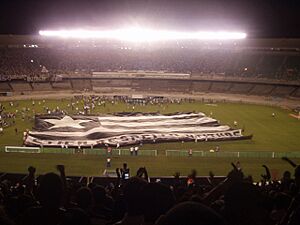
From 2005, Botafogo started to get better organized. This helped the team on the field. In 2006, they ended an eight-year period without titles. They won the Guanabara Cup and then the Carioca Championship. In 2007, the team played very well and was nicknamed "Black and white Carousel."
Despite playing good football, 2007 had no titles and some tough losses. In the Carioca Championship, they won the Rio Cup. But they lost the state final to Flamengo on penalties. In the Brazil Cup, they were eliminated in the semi-finals. Two goals were disallowed in a controversial match.
In the Brazilian Championship, Botafogo started strong. They led the tournament for 11 rounds. But internal problems caused their performance to drop. They finished 9th. A big moment in 2007 was getting the Nilton Santos Olympic Stadium. Botafogo leased the stadium until 2027.
In 2008, Botafogo won the Peregrino Cup. But in official tournaments, they had similar results to the previous year. They won the Rio Cup but were runners-up again against Flamengo. In the Brazil Cup, they were eliminated in the semi-finals on penalties.
In 2009, a new president, Mauricio Assumpção, was elected. The team had money problems. But they still won the Guanabara Cup. They reached the Rio Cup final but lost the chance to win the Carioca Championship to Flamengo. They lost to Flamengo for the third time in the final, again on penalties.
In the Brazilian Championship, the team started poorly. They were often in the relegation zone. But they managed to stay in the A Series for 2010. They secured this with a win over Palmeiras in the last game.
The 2010s: Ups and Downs
In 2010, the club signed Uruguayan player Loco Abreu. He wore the number 13 jersey, which excited fans. In the Carioca Championship, they lost 6–0 to Vasco. The coach was replaced by Joel Santana. Joel helped the team improve. They won the Guanabara Cup. In the Rio Cup final, they beat Flamengo 2–1. This secured the state title early.
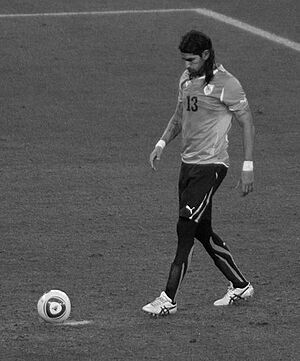
In the Brazil Cup, the team was eliminated early. In the Brazilian Championship, Botafogo was in the relegation zone. But they improved and fought for a spot in the Libertadores Cup. They didn't qualify. However, Jefferson was called to the Brazilian National team. Loco Abreu played in the 2010 World Cup for Uruguay.
In 2011, Botafogo had a bad start. The coach was fired. They were eliminated early from the Carioca Championship and the Brazil Cup. But in the Brazilian Championship, Botafogo played very well. They fought for a spot in the Libertadores Cup again. They finished 9th.
In 2012, Botafogo hired Oswaldo de Oliveira as coach. They focused on the Carioca Championship. They were the only team to finish both cups undefeated. But in the finals, they lost to Fluminense 4–1.
In the Brazilian championship, the club made a big signing: Dutch star Seedorf. He was presented on July 7. His first goal came two weeks later. In the Copa Sudamericana, the team was eliminated early. They finished 7th in the Brazilian championship.
In 2013, Seedorf led the team to win the Carioca Championship. They also won the Guanabara and Rio cups. The Brazilian championship started well. Botafogo led for six rounds. But player sales and salary delays caused problems. They were eliminated from the Brazil Cup. Despite this, they finished 4th in the Brazilian championship. This earned them a spot in the 2014 Libertadores Cup after 18 years.
In 2014, Botafogo had its worst Carioca Championship campaign. In the Libertadores Cup, despite great fan support, they were eliminated in the group stage. In the Brazil Cup, they had a historic comeback win. But they were eliminated in the next round. In the Brazilian Championship, with a weak team and late salaries, the club was relegated for the second time.
In 2015, Botafogo won the Guanabara Cup. But they finished runner-up in the state championship. They were eliminated from the Brazil Cup. The coach was fired. Ricardo Gomes took over. He led the team to win the B Series title. This secured their return to the main series. In 2016, they were runners-up in the Carioca Championship. They were eliminated from the Brazil Cup. In the Brazilian Championship, they started poorly. But they recovered and finished 5th. This earned them a spot in the Libertadores Cup.
In early 2017, Botafogo focused on the Libertadores Cup. They eliminated Colo-Colo and Olimpia. In the state championship, they finished runner-up in the Rio Cup. They qualified for the final round of the Libertadores by finishing first in their group.
In the second half of 2017, Botafogo reached the semi-final of the Brazil Cup. They were eliminated by Flamengo. In the Libertadores, they were eliminated in the quarterfinals by Grêmio. Botafogo made history by eliminating five former champions in one tournament. In the Brazilian Championship, they lost their Libertadores spot in the last round.
In 2018, the year started with problems. The coach was replaced. Botafogo lost in the semi-final of the Guanabara Cup. They were eliminated early from the Brazil Cup. Under new coach Alberto Valentim, the team improved. They reached the final of the Carioca Championship. They beat Flamengo in the semi-final. In the final against Vasco, Botafogo won 1–0 in the last minute. In the penalty shootout, Gatito Fernández saved two penalties. Botafogo won its 21st state title!
Later in 2018, the coach left. Botafogo had three more coaches that season. They were eliminated from the Sudamericana Cup. In the Brazilian Championship, they fought against relegation. But they finished 9th. The year also marked the retirement of idol Jefferson. He played 459 games for Botafogo.
In 2019, Botafogo had a bad season. They didn't do well in the Carioca Championship. They were eliminated early from the Brazil Cup and Sudamericana Cup. In the Brazilian Championship, they fought against relegation. They finished 15th. The year was also marked by player protests and money problems.
The 2020s: Challenges and a Comeback
The 2020 season started with hopes for a new project. But it turned out to be a difficult year for Botafogo. The COVID-19 pandemic stopped football for months. Games were played without fans. The club signed international stars Keisuke Honda and Salomon Kalou. But they didn't perform well. The team had eight coaches that season. In the Carioca Championship, they finished 5th. They were eliminated from the Brazil Cup. In the Brazilian Championship, the team had its worst points total ever. They were relegated for the third time.
In 2021, Botafogo hired Marcelo Chamusca as coach. They finished 6th in the Carioca Championship. They were eliminated from the Brazil Cup. The team's performance was inconsistent. The coach was fired. Enderson Moreira took over. Under the new coach, the club started to get organized. With players like Chay and Rafael Navarro, Botafogo played strongly at home. They won the B Series title with one game left. This was their second B Series championship. It was considered a very tough edition.
Basketball
Early Success and the Merger (1930s-1940s)
In the 1930s, Botafogo Football Club won the Carioca Championship five times in a row. They also won it in 1939. The Club de Regatas Botafogo also played in the tournament.
In the early 1940s, basketball was important for the clubs joining together. During a game, player Armando Albano collapsed and died. This sad event led the presidents of both clubs to merge them. This created the current Botafogo de Futebol e Regatas.
After the merger, Botafogo Football Club won the state championship again in 1942. Botafogo de Futebol e Regatas then won it for the next three years: 1943, 1944, and 1945. They also won in 1947. This showed their strength in Rio de Janeiro.
National Pioneers (1950s-1960s)
The first Carioca Women's Basketball Championship was in 1952. Botafogo won its first state title in 1955.
In the 1960s, both men's and women's teams won titles. The women's team won the state championship four times in a row. The men's team won the Carioca Championship three times. In 1967, Botafogo made history. They became the first Rio de Janeiro club to win the national basketball championship. They won the Brazil Cup. In the final, they beat Corinthians 85–84.
With the Brazilian title, Botafogo played in the 1967 Sudamericano Championship in Chile. They finished third. Botafogo was then chosen to represent South America in the 1968 FIBA Intercontinental Cup in the United States. They finished fourth in this World Championship.
Comeback and Challenges (1990s-2000s)
After two decades without major wins, Botafogo returned to success in the 1990s. In 1991, they beat Flamengo to become state champions. The women's team won the cup in 1995.
In 1999 and 2000, Botafogo reached the state final twice. But they lost to Flamengo and Vasco. In 2001, they did well in the National Championship. But the club closed its professional basketball department in 2002 due to financial issues. The women's team was state champion in 2006.
NBB Debut and Continental Title (2010s)
In 2012, Botafogo played in the Carioca Championship again. In 2015, they returned to professional basketball. They finished third in the state championship. That same year, the club ended its professional women's team.
In 2017, Botafogo played in the Golden League, the second division of Brazilian basketball. They finished first and won the championship. This earned them a spot in the Novo Basquete Brasil (NBB), the top league.
Botafogo debuted in the NBB on November 16. They won their first game. They reached the playoffs but were eliminated in the first round.
For the 2018–19 season, Botafogo hired coach Léo Figueiró. They signed new players. In the Carioca Championship, they reached the final for the first time in 18 years. But they lost to Flamengo.
In NBB 11, Botafogo finished 6th. They reached the semi-finals of the Brazilian Championship. This was their best result since 2001. Because of their 4th place finish, Botafogo earned a spot in the Sudamericana League.
In their first international competition since returning, Botafogo won the Sudamericana League! They beat Corinthians in the final. This was the first international title in Botafogo's basketball history.
Recent Years (2020s)
Even after winning a big title, Botafogo basketball faced problems in 2020. Players and staff were not paid for months. A sponsorship deal helped. But then another main sponsor changed its contract. This led to the club announcing the end of its professional basketball project on July 30, 2020. They gave up their spots in the NBB and Champions League Americas.
However, in November 2020, a new director was appointed. He recreated the team to compete in the second division. But Botafogo failed to return to the top tournament that year.
Swimming
Early Years and Federation (1890s-1900s)
Botafogo is one of Brazil's oldest swimming clubs. In Rio de Janeiro, swimming competitions started around the 1850s. On July 31, 1897, Botafogo was one of the founding clubs of the Metropolitan Swimming Federation. This is now called the Aquatic Federation of the State of Rio de Janeiro.
Golden Age (1960s-1970s)
In 1967, Botafogo won the Brazil Swimming Trophy for the first time. That same year, Botafogo swimmer José Sylvio Fiolo won gold medals at the Pan American Games. In 1968, Fiolo broke the world record for the 100-meter breaststroke.
In the 1970s, Botafogo competed with rival Fluminense. Botafogo was four-time champion of the Brazilian Swimming Trophy from 1971 to 1974. They were also four-time champion of the José Finkel Trophy from 1972 to 1975.
State Success (2000s-2010s)
In the early 2000s, Botafogo won state titles in many categories. They were Rio adult champions in 2005 and 2006. In 2010, they ranked 5th in the Brazilian Club Ranking. They won the State Efficiency Trophy for the sixth time. In 2011, Botafogo athlete Larissa Simões won a gold medal at the South American Youth Championships.
Water Polo
Early Years and First Titles (1910s-1960s)
Water polo started in Rio de Janeiro in the early 1900s. Botafogo Cove became a popular spot for the sport.
In 1942, Botafogo won the Carioca Championship for the first time. This was the last official title for Club de Regatas Botafogo before the merger. In the 1940s, the club won three more times. After a period without titles, they won again in 1963, 1965, and 1966.
National Success (1980s-1990s)
In the early 1980s, Botafogo was state champion in 1980, 1982, and 1983. They repeated this in 1995 and 1996. This period also marked their first national successes. They were two-time champions of the Brazilian Championship in 1995 and 1996.
Recent Dominance (2000s-2010s)
In the 21st century, the club won the Carioca Championship in 2005, 2006, 2009, and 2010. They won the National League (Brazilian Championship) in 2015. They also won the Brazil Trophy in 2016.
In 2009, the team started competing in women's tournaments. They have won three bronze medals and one runner-up finish. In 2014, they signed Brenda Villa, a famous American player. She was a four-time Olympic medalist.
In 2016, the men's team won the first South American Club League. Six Botafogo athletes were on the Brazilian National Team at the Olympic Games. The next year, Botafogo won the South American Club Championship.
Rowing
Botafogo's rowing club was founded in 1891. It started as Grupo de Regatas Botafogo. It is one of the most important sports in the club's history, along with football. Antônio Mendes de Oliveira, a Brazilian champion in 1902, was a great rower from the club. He later became Botafogo's president. Today, the club has many talented rowers. Botafogo's rowing is also strong in the Paralympics. Isaac Ribeiro, a three-time Brazilian champion, competed in the World Cup and the London Paralympics.
Volleyball
Strong Start (1930s-1950s)
Botafogo was a pioneer in volleyball in Rio de Janeiro. They won the first five Men's Carioca Championship titles, from 1938 to 1942. They won again in 1945, 1946, and 1950. The women's team won the Carioca Championship in 1939, 1940, and from 1946 to 1950.
South American and Brazilian Champions (1960s-1970s)
After a break, Botafogo won the Men's Carioca Championship again in 1962. By the end of the 1970s, Botafogo became the tournament's biggest champion. They won it thirteen more times, including eleven in a row. During this time, the club became a major power in volleyball. They won the South American Championship three times. They were also Brazilian champions four times. In total, the club won over 30 titles between 1965 and 1978.
While the men's team was very successful, the women's team won one professional title. In 1964, they won the Women's Carioca Championship.
Decline and Return (1980s-2010s)
After their golden age, Botafogo slowly stopped focusing on volleyball. The men's team last played a national competition in 1984. Since then, they only played in state tournaments. The women's team became state champion in 1995.
In 2007, 28 years after their last win, Botafogo won the Men's Carioca Championship again. In 2013, the club returned to national competition after 29 years. The women's team reached the state runner-up title in 2008. In 2015, they won the Rio Cup.
In 2015, Botafogo won the Men's Rio Cup. This allowed them to play in the 2016 Superliga B, the second division. However, they were eliminated in the semi-final. In 2017, they again failed to get promoted. They lost in the semi-final.
In 2019, they finally got promoted! Botafogo won all seven games in the qualifying round. They reached the playoffs as favorites. They won their semi-final games. This secured their promotion to the main league after 35 years. In the final, Botafogo became champion of Superliga B. However, the club closed the professional volleyball team before the new season started. They said it was due to money problems.


